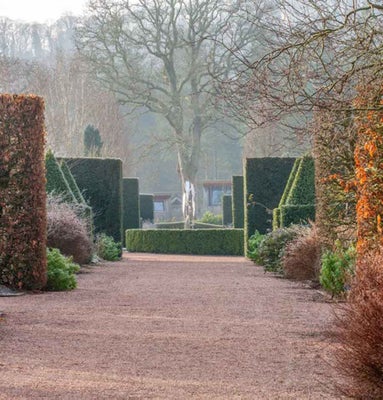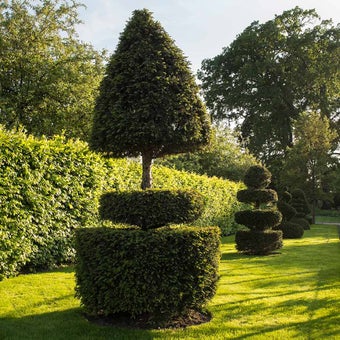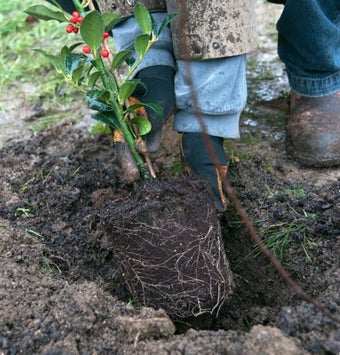
Quick facts
Top hedging plants:
Conifer - Taxus baccata (yew)
Large evergreen - Prunus lusitanica (Portuguese laurel)
Low growing - Lavandula angustifolia(lavender)
Native - Carpinus betulus (hornbeam)
Practical considerations
Choosing plants for a hedge can be made easier by giving some thought to the following:
- Decide on the type of hedge e.g. evergreen, , flowering, formal or informal
- Identify any specific requirements, such as height to be achieved and maintained
- Take into account the soil conditions and situation. Choose plants that tolerate such sites
- Check which hedges grow locally in similar situations and soil conditions
- Consider the amount of annual maintenance it will need once established. The timing and frequency of pruning depends on the species and the general effect required
- informal or semi-formal hedges will help attract wildlife, providing shelter and food
Evergreen or deciduous?
Evergreens make fine hedges and obviously the bonus is having shelter or privacy all year round. However, they do tend to take more maintenance and need to be pruned annually, ideally twice a year. Conifers are popular evergreen choices, but need to be pruned regularly as (with the exception of yew) neglected or overgrown conifer hedges cannot be restored.
Deciduous plants also make fine hedges, and indeed a beech hedge over winter holding onto its brown leaves is very pretty. You won't get the same privacy with a deciduous hedge as you do with an evergreen. An advantage of a deciduous hedge is that it will filter wind in winter avoiding the damaging turbulence associated with dense evergreen hedges. They are more forgiving with pruning, and although they should be trimmed in late summer, if you miss a year or two they will respond well to renovation.
Buying plants
Buying hedging plants in bulk from specialist growers is generally cheaper than from retail outlets.
Smaller transplants (also called whips) about 60cm (2ft) establish more rapidly than larger plants, which can often suffer from establishment problems especially during periods of extreme weather such as drought or excess moisture levels. But if you want to create a hedge quickly, buying semi-mature plants is the way to go. They are more expensive, and you will need to pay special attention to watering over the first two years.
Plant selection
Key
S = maintain at 30-90cm (1-3ft)
M = maintain at 90-120cm (3-4ft)
M-L = maintain at 90-180cm (3-6ft) or as taller hedges or screens
L = can be maintained at over 180cm (6ft)
Spacing
Numbers denote suggested spacings for planting in average conditions. In poor soils or difficult conditions, spacings may need to be slightly reduced.
1 = 10-15cm (4-6in) apart
2 = 30cm (1ft) apart
3 = 37.5cm (15in) apart
4 = 45cm (18in) apart
5 = 50cm (21in) apart
6 = 60cm (2ft) apart
7 = 75cm (30in) apart
8 = 90cm (3ft) apart
Conifers
- Chamaecyparis lawsoniana (Lawsons cypress) M-L (5-6): 'Fletcheri’ AGM, greyish-green, feathery, ‘Green Hedger’ AGM, rich green, ‘Stewartii’, golden
- × Cuprocyparis leylandii (Leyland cypress) L (6–7): Bright yellowish-green, rather coarse, very rapid in growth, useful as a quick growing tall screen but less satisfactory as a smaller trimmed hedge, must be planted and maintained with care. ‘Castlewellan’, young shoots yellow, less vigorous than the above form, ‘Robinson’s Gold’, young growths bronze-gold
- Cupressus macrocarpa (Monterey cypress) M-L (6): Green, rapid growth, not fully frost-hardy and not suited to cold inland areas. Best as an informal screen. Intolerant of topping or reducing in height. ‘Golden Cone’, golden yellow foliage, ‘Goldcrest’ AGM, golden yellow foliage, ‘Lutea’, yellow first year foliage
- Taxus baccata (yew) M-L (4–6): An excellent choice for a formal dense hedge. Growth is slower than other conifers but can make 30cm (1ft) growth annually in good conditions. Overgrown hedges can often be restored by hard pruning in late winter. ‘Elegantissima’ AGM, the only golden yew suitable for a screening hedge
- Taxus × media, ‘Hicksii’ AGM S-M (4–6): broadly columnar habit
- Thuja plicata ‘Atrovirens’ (Western red cedar) AGM M-L (6): Bright green, rapid growth
Evergreens (excl. conifers)
- Aucuba japonica ‘Crotonifolia’ (spotted laurel) M-L (6): Glossy, spotted foliage
- Berberis darwiniiAGM M (6): Flowers bright orange, tinged red in spring
- Berberis × stenophylla AGM M-L (6): Flowers yellow, arching branches as an informal hedge
- Berberis verruculosa AGM S-M (5-6): Flowers solitary, yellow, compact
- Brachyglottis monroi (syn. Senecio monroi) S (3): Yellow flowers, young leaves silvery grey
- Buxus sempervirens(box) S-M (3-4): ‘Elegantissima’ AGM, leaves, S-M (3-4), ‘Suffruticosa’, a dwarf form often sold by the metre S (1)
- Corokia × virgataM-L (5): Milder coastal areas
- Cotoneaster lacteusAGM L (7-8): Late-ripening clusters of red berries
- Cotoneaster franchetii L (5): Semi-evergreen, leaves sage green, berries orange-scarlet
- Elaeagnus × ebbingeiAGML (6): Leaves large, silvery beneath, fast-growing
- Escallonia rubra ‘Crimson Spire’ AGM M-L (6-7): Large-leaved, erect. ‘Donard Radiance’ AGM, flowers rose-red, vigorous, compact, ‘Pride of Donard’ AGM, flowers brilliant rose-red, ‘Langleyensis’ AGM, tall, arching, flowers rose-pink
- Escallonia rubra var. macrantha M-L (6-7): Coastal areas only, flowers crimson
- Euonymus fortunei ‘Emerald Gaiety’ AGM S (2): Leaves margined white. ‘Emerald ‘n’ Gold’ AGM, leaves margined gold
- Euonymus japonicusM-L (4-5): Leaves dark, glossy green, variegated forms available
- Griselinia littoralis AGM M (6): Mild coastal areas only, leaves leathery, apple green
- Hebe brachysiphonM-L (6-7): Coastal areas only
- Hebe × franciscana ‘Blue Gem’ AGM S (4): Coastal areas only
- Hebe salicifoliaM-L (6-7): Coastal areas only, flowers white
- Ilex × altaclerensis ‘Hodginsii’ (holly) AGM M-L (4-5): Vigorous, male, leaves variable spiny
- Ilex aquifolium (common holly) ‘J C van Tol’ AGM M-L (4-5): Female, leaves almost spineless. ‘Madame Briot’ AGM, gold variegated leaves, female, free-berrying, spiny, ‘Argentea Marginata’ AGM, white margined leaves, female, free-berrying
- Ilex × meserveae (holly) BLUE PRINCESS 'Conapri' AGM S-M (4): Female, dark, glossy blue-green leaves, BLUE PRINCE 'Conablu', male; leaves dark, glossy blue-green
- Lavandula angustifolia (lavender) ‘Hidcote’ AGM S (2-3): Neat compact, spikes dense, deep
lilac. ‘Loddon Pink’, compact, flowers pale pink, ‘Munstead’, compact, flowers blue-violet - Ligustrum delavayanumM-L (3): Not for cold areas. A small leaved kind of privet
- Ligustrum ovalifolium (common privet) M-L (3): A good choice, but prone to honey fungus. ‘Aureum’ (golden privet) AGM, has tendency to revert
- Lonicera ligustrina var. yunnanensis 'Maigrün' S-M (3): Strong-growing, erect. ‘Baggesen’s Gold’ AGM, yellow-leaved
- Olearia × haastii S-M (4): Milder coastal areas only, flowers white, in June
- Olearia macrodontaAGM S-M (6): Milder coastal areas only, leaves sage-green, flowers white
- Osmanthus × burkwoodiiAGM M-L (5): Compact habit, slowish growth, flowers white fragrant, in spring
- Osmanthus delavayiAGM M-L (5): Similar to above; flowers larger
- Photinia × fraseri ‘Red Robin’ AGM M-L (5-6): Coppery red new growths
- Pittosporum tenuifoliumAGM L (5): Pale green leaves, black twigs, milder coastal areas only
- Prunus laurocerasus (cherry laurel) ‘Rotundifolia’ M-L (6): Erect bushy habit. ‘Herbergii’, erect compact habit
- Prunus lusitanica (Portugese laurel) AGM M-L (6): Dense bushy evergreen, tolerant to partial shade. ‘Variegata’, white-margined leaves
- Pyracantha ‘Orange Glow’ AGM M-L (5): Dense habit, orange-red berries. ‘Soleil d’Or’, golden yellow berries,‘Watereri’ AGM, compact, free-flowering, bright red berries, SAPHYR range claim good resistance to pyracantha scab
- Pyracantha rogersianaAGM M-L (5): Red-orange berries
- Rhododendron ponticum L (6-8): Acid soils only
- Rosmarinus officinalis (rosemary) ‘Miss Jessopp’s Upright’ AGM S-M (5-6): Erect habit
- Santolina chamaecyparissusS (2): Silvery foliage, lemon yellow flowers
- Santolina chamaecyparissus 'Nana'AGM S (1): Dwarf form of above
- Viburnum tinus ‘Eve Price’ AGM M-L (6): Good choice for winter flowering
Deciduous
- Acer campestreAGM (field maple) M-L (4): Attractive rural hedge; good autumn colouring
- Alnus cordataAGM (Italian alder) L (8): Useful for tall hedges on wet soils
- Berberis × ottawensis f. purpurea ‘Superba’ AGM M (6): Rich purple foliage, yellow flowers
- Berberis thunbergii‘Erecta’ S-M (6): Compact, good autumn colour, ‘Atropurpurea Nana’ AGM, purple foliage; dwarf habit S (2)
- Carpinus betulus AGM (hornbeam) M-L (4): Similar to beech though it does not hold the leaves for as long. Better suited for cold situations than beech
- Cotoneaster simonsiiAGM M-L (4): to semi-evergreen, erect habit, scarlet fruits
- Crataegus monogyna(quickthorn or hawthorn) M-L (2): Thorny, dense if regularly trimmed
- Fagus sylvatica (beech) AGM M-L (4-6): Suitable for formal hedges. Provides screening in winter as it retains brown leaves until spring. See page on beech hedging
- Fagus sylvatica (purple-leaved beech) Atropurpurea Group M-L (4-6): Seed raised and variable but usually fairly true to colour
- Fagus sylvatica (copper beech) (Atropurpurea Group) ‘Riversii’ AGM M-L (4-6): Grafted and more expensive than paler leaved copper beech
- Fuchsia magellanica var. gracilis ‘Variegata’ AGM M-L (4): Only milder coastal areas. ‘Riccartonii’ AGM
- Genista hispanica S (3): Prickly, yellow flowers in spring
- Hippophae rhamnoides AGM (sea buckthorn) M-L (7): Only milder coastal areas
- Hypericum forrestii AGM M (5): Golden yellow flowers in summer
- Hyssopus officinalis (hyssop) S (1-2): Shrubby aromatic herb
- Potentilla fruticosa‘Jackman’s Variety’ S (5-6): Yellow flowers in summer
- Prunus cerasifera (myrobalan or cherry plum) ‘Nigra’ AGM L (6): Deep purple foliage, thorny
- Prunus × cistena AGM S-M (4-5): Reddish foliage
- Prunus spinosa (blackthorn or sloe) L (6): Strong-growing, thorny rural hedge
- Rhododendron luteumAGM L (6): Acid soils only, fragrant yellow fls. in spring
- Ribes sanguineum (flowering currant) ‘Pulborough Scarlet’ AGM M-L (6): A cultivar with deep red flowers
- Rosa (rose) Large forms (7-8): ‘Blanche Double de Coubert’ AGM, ‘Buff Beauty’ AGM, ‘Penelope’ AGM, ‘Roseraie de l’Hay’ AGM, ‘The Queen Elizabeth’ AGM, ‘Vanity’, R. rugosa ‘Alba’ AGM
- Rosa (rose) Medium forms (5-6): ‘Fru Dagmar Hastrup’ AGM, ‘Ispahan’ AGM, Alexander = ‘Harlex’ AGM, Iceberg = 'Korbin' AGM, Eye Paint = ‘Maceye’ AGM, R. rubiginosa AGM (syn. R. eglanteria)
- Rosa (rose) Small forms (4): ‘Ballerina’ AGM, R. gallica ‘Versicolor’ AGM, R. gallica var. officinalis AGM, ‘The Fairy’ AGM
- Spiraea ‘Arguta’ (syn S. × arguta ‘Bridal Wreath’) M (6): Slender, arching branches; white flowers in the spring
- Spiraea japonica ‘Goldflame’ AGM S (3): Golden foliage, crimson flowers
- Spiraea ‘Anthony Waterer’ AGM S-M (4-6): Compact, free-flowering, variegated
- Symphoricarpos albus var. laevigatus(snowberry) M-L (5-6): Strong-growing, suckering growth, good for shade
- Symphoricarpos × doorenbosii (snowberry) ‘White Hedge’ M (6-7): Strong, erect habit, large white berries in winter
- Syringa meyeri ‘Palibin’ AGM (syn. S. palibiniana) S (5): A compact, slow-growing kind of lilac
- Viburnum farreri AGM (syn. V. fragrans) M-L (5-6): Flowers through the winter
- Viburnum opulus ‘Compactum’ AGM S-M (5-6): White flowers in spring, then dark red fruits
- Weigela ‘Bristol Ruby’ M (4-5): Vigorous, erect habit
- Weigela florida ‘Foliis Purpureis’ M (5-6): Purplish leaves, pink flowers
- Weigela ‘Florida Variegata’ AGM M (5-6): Leaf margins creamy white, pink flowers
Hedges for special situations
S = maintain at 30-90cm (1-3ft)
M = maintain at 90-120cm (3-4ft)
M/L = maintain at 90-180cm (3-6ft) or as taller hedges or screens
L = can be maintained at over 180cm (6ft)
Thorny hedges for security
Also see our page on garden security.
- Berberis × stenophylla M-L
- Crataegus monogyna(quickthorn or hawthorn) M-L
- Genista hispanicaS
- Hippophae rhamnoides (sea buckthorn) M-L
- Ilex aquifolium (holly) M-L
- Prunus spinosa (blackthorn or sloe) L
- Pyracantha (firethorn) M-L
Plants for shade
Also see our page on plants for shade.
- Aucuba japonica (spotted laurel) M-L
- Buxus (box) S-L
- Euonymus fortunei ‘Emerald Gaiety’ or ‘Emerald ‘n’ Gold’ AGM S
- Ilex aquifolium (common holly) AGM M-L
- Ilex × altaclerensis ‘Hodginsii’ (holly) AGM M-L
- Prunus laurocerasus(cherry laurel) M-L
- Prunus lusitanica (Portugese laurel) M-L
- Symphoricarpos (snowberry) M-L
Hedges for heavy clay
Also see our page on plants for clay soils.
- Berberisevergreen and (B. darwiniiAGM M, B. verruculosaAGM S-M, B. thunbergiiM)
- Cotoneaster simonsii M-L
- Cotoneaster franchetii L
- Escallonia M-L
- Euonymus japonicus M-L
- Ilex × altaclerensis ‘Hodginsii’ (holly) AGM M-L
- Osmanthus delavayi M-L
- Potentilla fruticosa‘Jackman’s Variety’ S
- Prunus laurocerasus L
- Prunus lusitanica (Portugese laurel) M-L
- PyracanthaM-L
- Ribes sanguineum (flowering currant) ‘Pulborough Scarlet’ AGM M-L
- Spiraea S-M
- Symphoricarpos albus var. laevigatus (snowberry) M-L
- Syringa meyeri ‘Palibin’ AGM (syn. S. palibiniana) S
- Viburnum M-L
Chalky soils
Also see our page on plants for chalky soils.
- Lonicera nitida (evergreen honeysuckle) M
- Berberis darwinii M
- Chaenomeles japonica (Japanese quince) S-M
- Olearia × haastii S-M: Milder areas
- Osmanthus× burkwoodii M-L
Wet soils
Also see our page on trees for wet soils.
- Alnus cordata (Italian alder) L
- Crataegus monogyna(quickthorn or hawthorn) M-L
- Rhododendron luteumAGM L
- Salix (willow) M-L
- Spiraea S-M
- Symphoricarpos albus var. laevigatus(snowberry) M-L
- Thuja plicata ‘Atrovirens’ (Western red cedar) AGM M-L
- Viburnum opulus ‘Compactum’ AGM S-M
Seaside gardens
Also see our page on plants for coastal locations.
- Brachyglottis monroi (syn. Senecio monroi) S
- Corokia × virgata M-L
- Cotoneaster lacteusAGM L
- Cupressus macrocarpa (Monterey cypress) M-L
- Elaeagnus× ebbingei M-L
- Escallonia ‘Donard Seedling’ M-L
- Euonymus japonicusM-L
- Fuchsia ‘Riccartonii’ M-L (milder areas only)
- Griselinia littoralis M-L
- Hebe brachysiphon M-L
- Hebe × franciscana ‘Blue Gem’ AGM S
- Hebe salicifoliaM-L
- Hippophae rhamnoides (sea buckthorn) M-L
- Olearia × haastii S-M
- Olearia macrodonta AGM S-M
- Pittosporum tenuifoliumAGM L
- Rosa rugosa M-L
- Santolina chamaecyparissusS
- Tamarix (tamarisk) M-L
Cold, exposed inland situations
Also see our page on plants for a cold climate.
- Berberis × stenophyllaAGM M-L
- Carpinus betulus (hornbeam) M-L
- Crataegus monogyna (hawthorn) M-L
- Fagus sylvatica (beech) AGM M-L
- Ilex aquifolium (common holly) M-L
- Prunus laurocerasus(cherry laurel) M-L
- Prunus lusitanica (Portugese laurel) M-L
- Taxus baccata (yew)
- Thuja plicata ‘Atrovirens’ (Western red cedar) AGM M-L
Feature hedges with bright or variegated foliage
- Viburnum tinus ‘Variegatum’ S-M
- Elaeagnus pungens ‘Maculata’ M
- Choisya ternata ‘Sundance’ S-M
- Ligustrum ovalifolium ‘Aureum’ M-L
- Photinia× fraseri ‘Red Robin’ M-L: Prone to leaf spotting due to winter cold and wet
Low-growing hedges
- Berberis microphylla 'Pygmaea' S
- Berberis × stenophylla 'Corallina Compacta' S
- Buxus sempervirens 'Suffruticosa’ (box) S
- Euonymus fortunei cultivars S
- Ilex crenataS
- Lavandula angustifolia S
- Santolina chamaecyparissus var. nanaAGM S
Narrow hedges - if carefully clipped
- Berberis verruculosa S-M
- Buxus sempervirens ‘Handsworthiensis’ S-M
- Cotoneaster franchetii L
- Cotoneaster simonsii M-L
- Ligustrum delavayanumM-L
- Lonicera ligustrina var. yunnanensis 'Maigrün' S-M
- Osmanthus × burkwoodiiAGM M-L
- Osmanthus delavayi M-L
- Taxus baccata M-L
Native hedging
Also see our page on trees and shrubs native to the UK.
- Acer campestre (field maple) M-L: Good autumn colour
- Crataegus monogyna (hawthorn) M-L: Thorny and dense if regularly pruned
- Ilex aquifolium (common holly) M-L: Both male and female plants required to produce berries
- Ligustrum vulgare (wild privet) M-L: This is semi-evergreen in colder winters
- Prunus spinosa (blackthorn, sloe) L: Good for a thorny rural hedge










